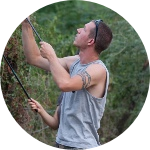About This Project
My research investigates why animals are shaped the way that they are shaped. I focus on gecko lizards, and their sticky toe pads. There is much variation in toe pad shape and size across species, suggesting that geckos are likely adapted to particular environments, yet no one has investigated how species use different habitats. I plan to measure the texture of surfaces used by geckos in Madagascar to see which kinds of toe pads are adapted to which environments.
Ask the Scientists
Join The DiscussionWhat is the context of this research?
My research focuses on gecko adhesive performance, an excellent system to study questions of adaptation with applications in producing synthetic gecko-like adhesives. Gecko toe pads are organized hierarchically (see video), with tiny hair-like structures called setae on the bottom of each toe. Interacting with a surface via van der Waals forces, setae are responsible for producing strong forces that allow geckos to climb surfaces. Gecko toe pads stick to rough and smooth, wet and dry surfaces, self-clean, and do not become matted. Despite these requirements, toe pad shape, setal length, diameter, density, and organization vary extensively across species. This variation suggests the gecko adhesive system likely adapted to particular environments, yet this adaptation is likely complex.
What is the significance of this project?
Surface texture directly affects how a gecko sticks to a surface. Gecko toe pads have groups of branched hair-like structures called setae. Different sized surface textures help or hinder geckos ability to stick based on the size of the surface variations and the size and shape of the toe pad and hairs. This relationship between surface texture and stickiness has only been look at in the lab. I want to look at surfaces geckos actually use in the wild. These measurements will allow me to not only understand how different geckos have adapted to different surfaces, but also help design adhesives that copy gecko toe pads stick to different kinds of surfaces.
What are the goals of the project?
This project will measure the texture of surfaces used by geckos in the wild in Madagascar. We will use a soft polymer to make surface casts of the trees and rocks we observe geckos using. We will compare these measurements to the toe pads of the species using these surfaces.
Field work in Madagascar can be difficult and getting all of the proper approvals to work with live animals in that country takes time and patience. Planning the travel for this type of field work usually begins a year before the trip actually occurs. I will start planning this trip in the fall of 2016 and actually do the trip in the fall of 2017.
Budget
These costs are needed to do fieldwork in Madagascar. I am asking for travel related costs and costs associated with doing scientific research in a foreign county.
I am also applying for additional funds outside of Experiment.com to cover a field assistant, microscope use time, online data storage, publication costs, and travel to cover presenting my results at universities and public events.
Endorsed by
Meet the Team
Travis Hagey
I first began studying lizards as an undergraduate student. I signed up for a field ecology course in southeastern Oregon studying the foraging behavior of desert lizards. This course combined science and camping!
My current research tried to understand how animals have adapted to different environments. My work combines studying animals in the lab with experiments in the field. I often apply mechanical ideas to animal locomotion, measuring the forces animals produce during movement. I really enjoy the combination of mechanics and biology that studying geckos allows.
Project Backers
- 6Backers
- 4%Funded
- $279Total Donations
- $46.50Average Donation

